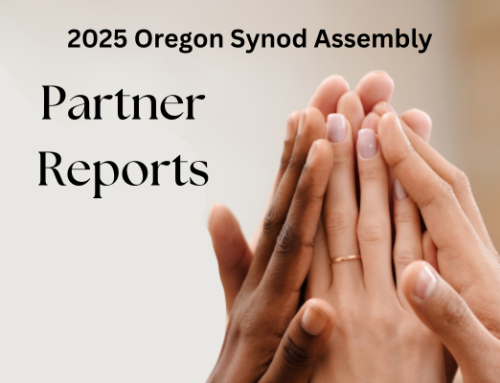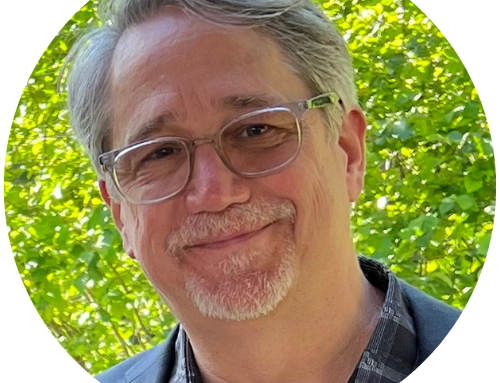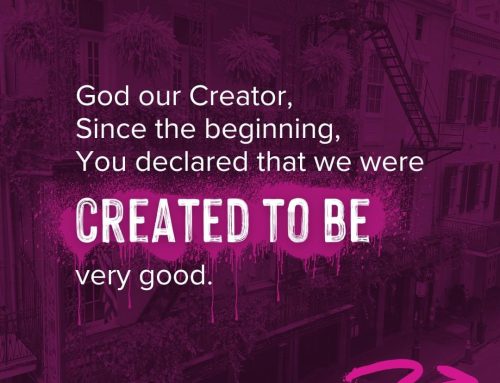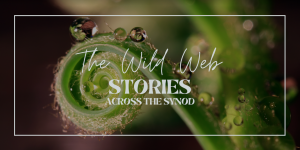
Knit Together through the Land
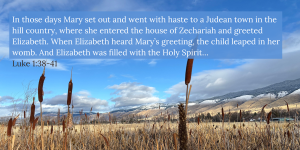
On a cold, clear Saturday morning this November, a circle starts to form in a windowed room of the Ascension School in Cove, Oregon. Fields dotted with farmhouses stretch out, like a gold carpet announcing the Blue Mountains hugging her basin, our gathering place, our host.
The first to arrive are the anticipating conveners: Nancy, Bruce, Cilla, and Theresa, Zion Lutheran and LaGrande United Methodist Church’s ecumenical Climate Resilience Team, met by Bobby Fossek and Brosnan Spencer, setting up a colorful display of First Foods. Naknuwiłama Tiiča̓mna, “Caretakers of the Land,” these Indigenous leaders work to repair the ecosystems of the land of the Ascension School, owned and stewarded since the 1920s by the Episcopal Diocese of Eastern Oregon, back to its pre-colonial habitats. Amy Jayne, the school’s director, a newly ordained Episcopal priest, greets us in well-worn hiking boots, her palms hugging a steaming cup of coffee. “There’s a buzz in our little town!” She exclaims. “People are coming. They are curious!”
Within the half-hour, doors open and a line starts to form at the registration table. Some bypass it to relieve themselves of their jackets, hats and mittens, claiming a chair in our circuitous setup. The other entryway ushers in another stream of arrivals. I am a guest from the west, so I know few people beyond our team and my colleague, Pr. Roberta Smythe, but witness the delight and surprise as people greet one another: “I didn’t know you would be here!” It’s like an extended family reunion, with some distant cousins meeting for the first time. “Oh,” I hear. “It’s so good to finally meet you! I’ve heard about you for years.” And, from the introductions I catch, it seems the buzz extended as far as Pendleton and Baker City, to include local environmental groups and educators. Soon, our prearranged chairs are full and we need to widen the circle. Again, and again. We have grown to fifty strong. It feels like it is time to begin.
Over the next three hours we listen for the stories the land longs to tell – beautiful truths, painful truths. We go outside, touch the earth and encounter the truth of the land beyond commodification: living, sacred and full of memory. Pinecones preach. A raptor reads the scripture of the sky. Amy tells the truth of the Church – she doesn’t mince words – her own spiritual ancestors’ development of the Doctrine of Discovery to justify European settlement over these lands and, violently, over the land’s peoples.
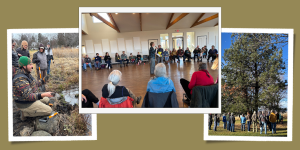
Each honest word spoken makes room for another voice.
Bobby rises and shares the truth of Grandmother Huckleberry and sibling salmon, and the truth of the destructive force of colonization in the words and worlds of the sacred stories of his people. Colonization, a hungry monster devouring life, evokes and resonates with my own spiritual ancestor’s sense of sin: objectification and consumption of life. Grief is thick in Bobby’s voice, but so is trust – trust in Creator and trust in the wild web of relationship among the waters and the wild celery and the camas, and now, trust in the Spirit knitting together this pregnant circle of unlikely kin on a Saturday morning.
We turn to the familiar strangers become neighbors now siblings around us and stories rise up from the bellies gathered: generations of life made on the land, the anguish of what our young generations face and the burning fire to accompany them in loving the land and her peoples, telling the truth, and repairing the racialized and ecological harm that plague our communities. And the humble confession: I don’t know my story of the land, our story of one another, and I want to.
The local Meadowlark Singers’ Threshold choir, an intergenerational group of women who sing at the bedsides of the dying, gather their a cappella harmonies around our tender truths, ushering us through the death of our own amnesia into the life and potency of relationship grounded in new clarity. Arms extended outward – we reach toward and bless a horizon we couldn’t glimpse before, emerging from our silos of faith and organizations, shame and grief, and returning to one another in ancient ways, struggling our way into new stories wanting to be born, stories we pray are world stirring, healing and restorative. The kinds of stories that rise out of small places like Cove and the hill country of Judah and must be sung because they are so unlikely and our deepest truths.
Bobby and Brosnan then bring us outside to the fields to put our hands in the earth, transplanting wapato, planting wild celery and Indian rice, stewarding the land forward in more ancient, sustainable ways so she may heal and provide us healing. Afterall, this birthing of more whole worlds is an earthy and full-bodied labor. Some of us are also guided in the craft of cyanotypes, a process of printmaking with natural elements and the sun – icons through which to remember where we come from and where we are surely headed, together.

